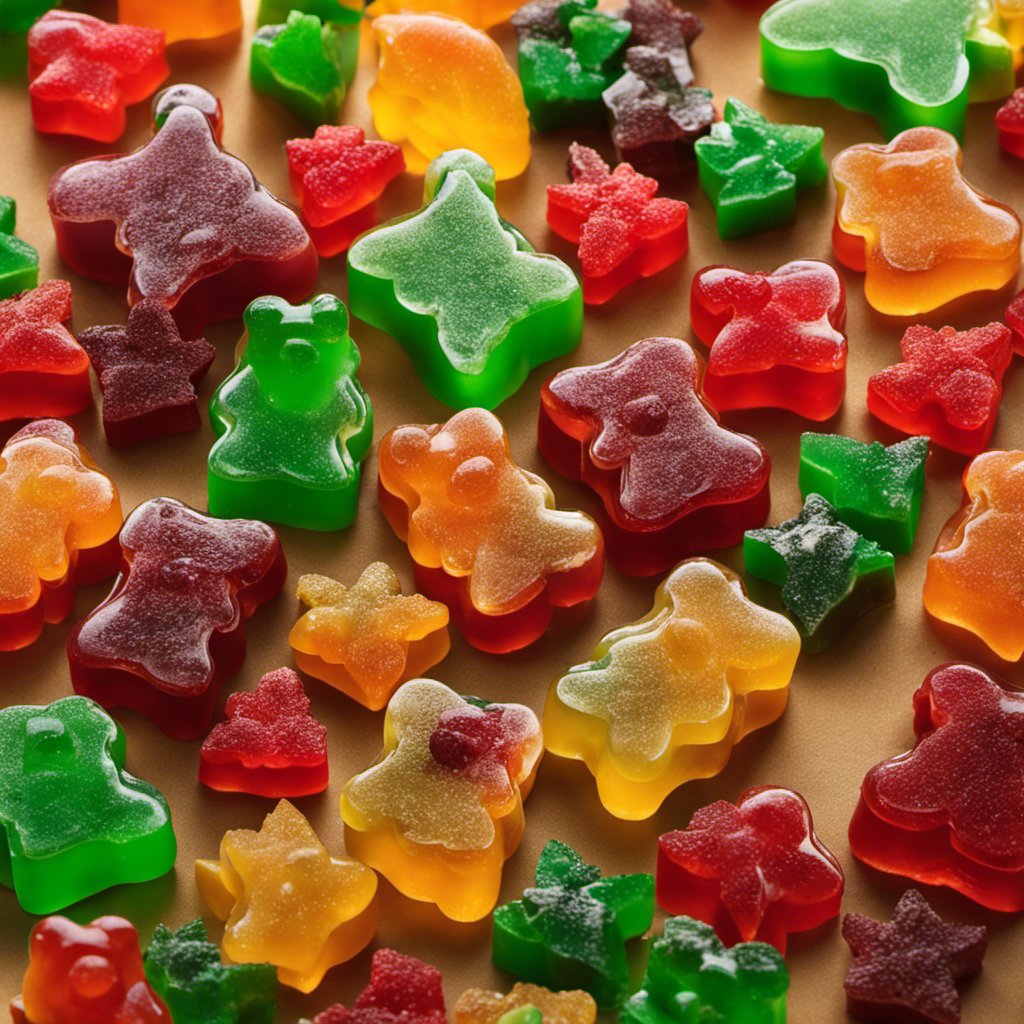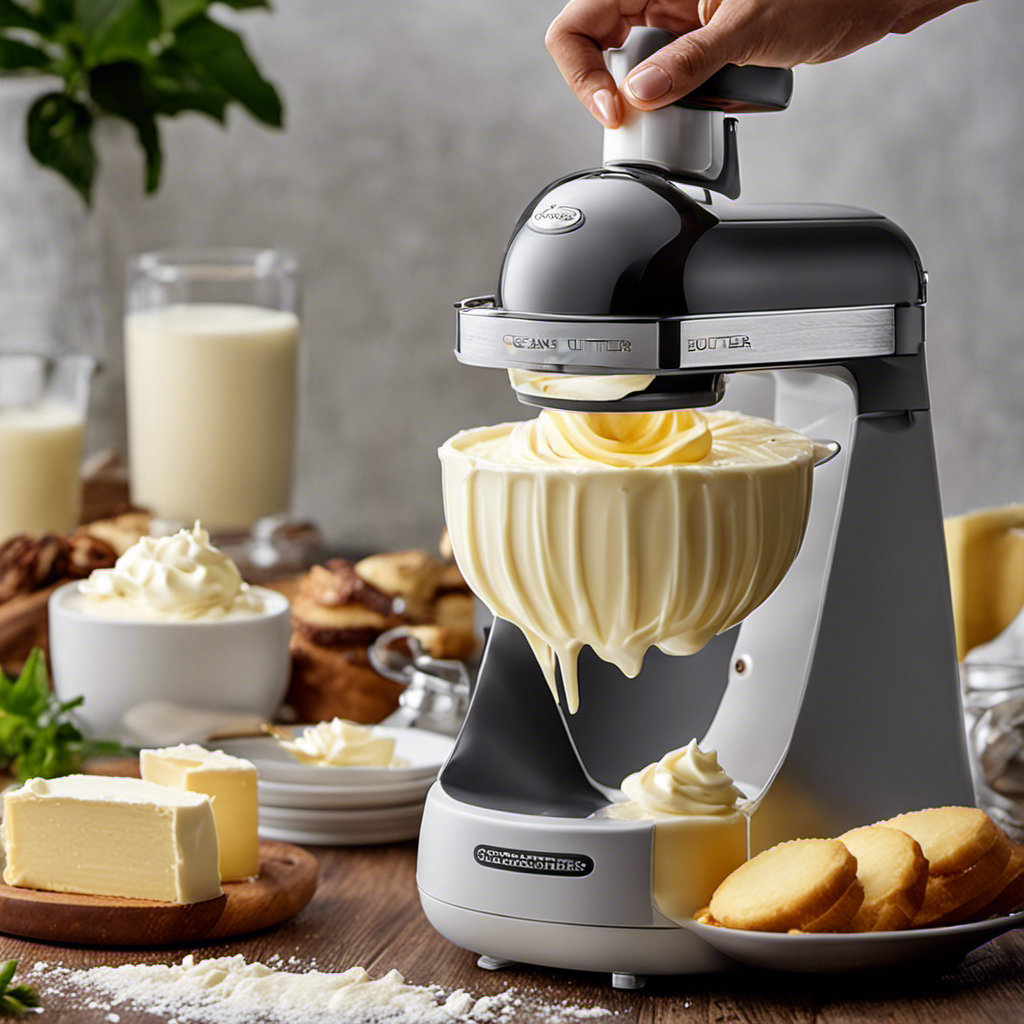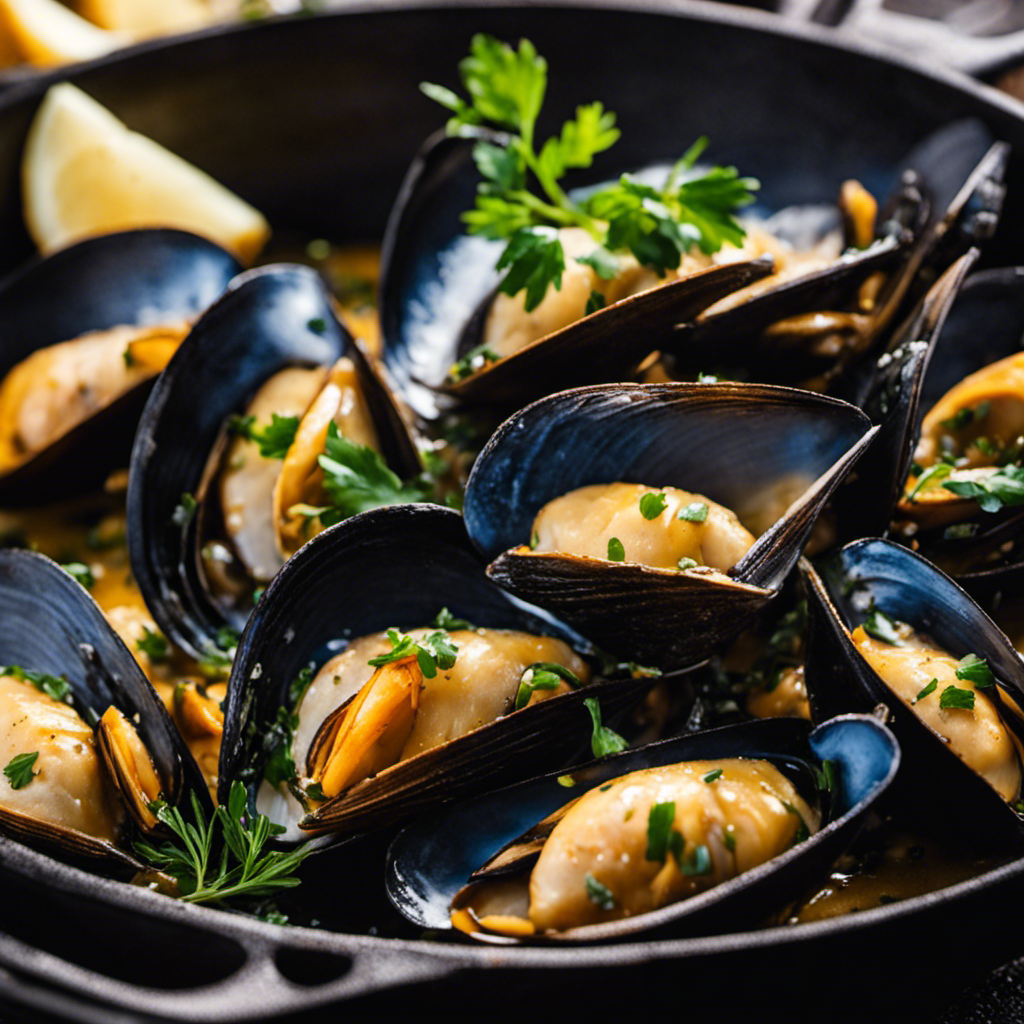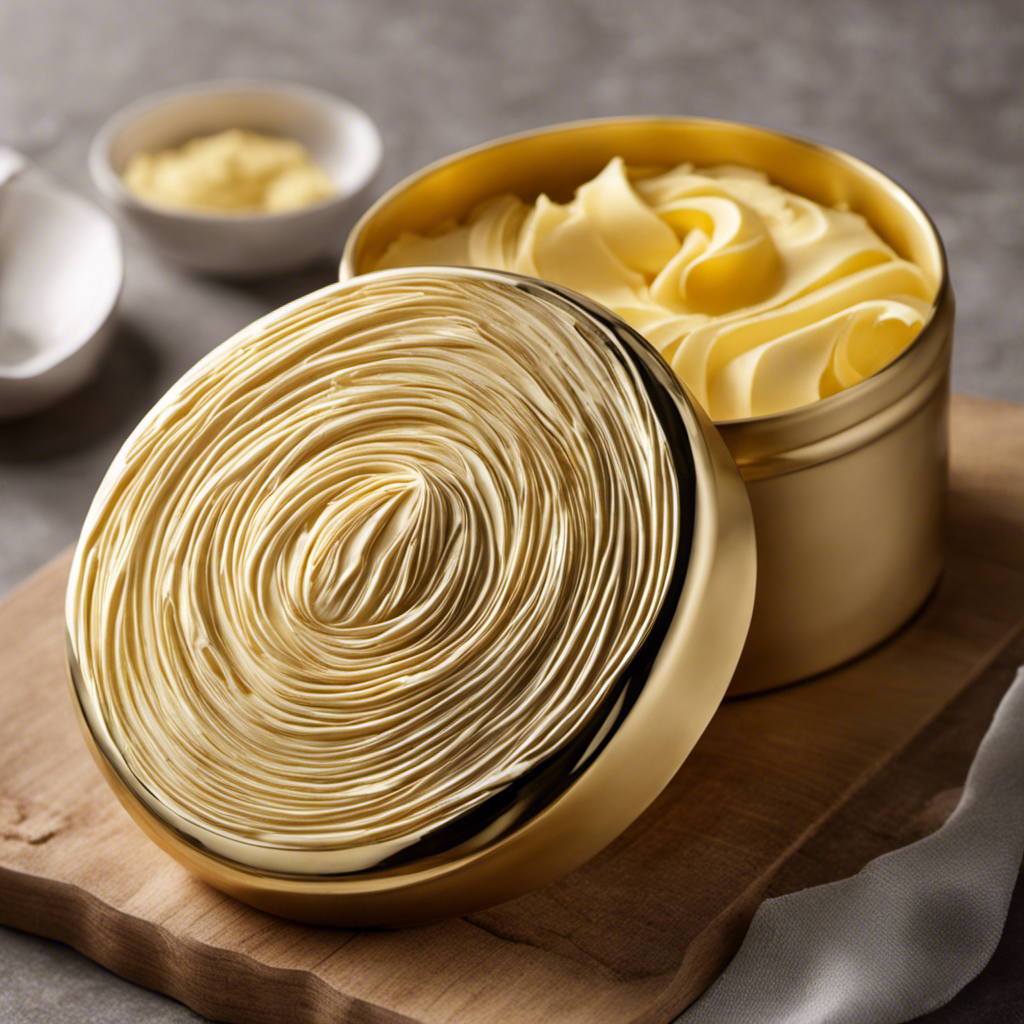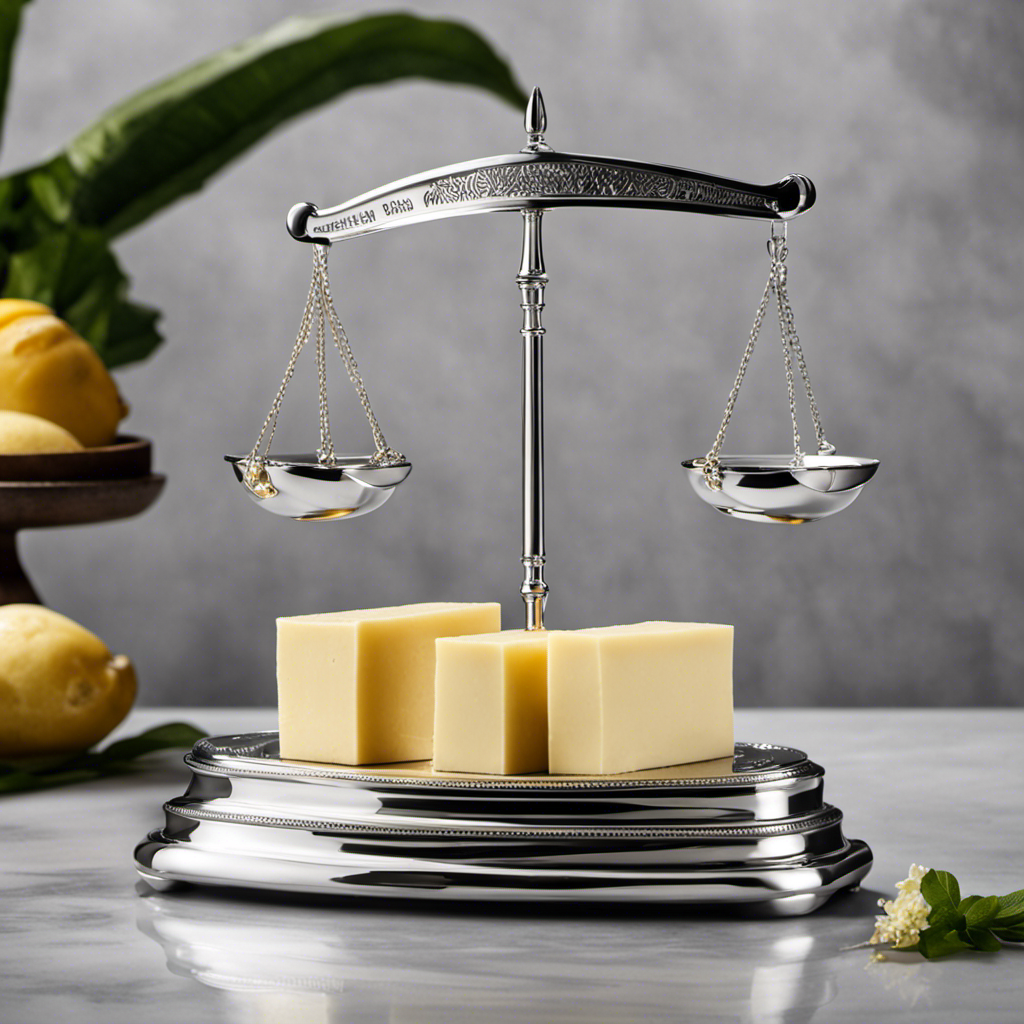I enjoy creating treats from scratch, particularly those with an added punch. This is why I’m thrilled to present my technique for crafting THC-infused gummies with the help of the Magic Butter Maker.
With just a few simple steps, you can infuse your gummies with the perfect amount of THC for a deliciously elevated experience. So gather your ingredients, prepare your Magic Butter Maker, and get ready to embark on a tasty adventure in homemade edibles.
Let’s dive in!
Key Takeaways
- Accurately measure THC oil or tincture and gelatin powder and sugar for precise dosage and consistency.
- Select the appropriate strainer option (fine mesh or cheesecloth) and practice patience during the time-consuming straining process.
- Infused butter adds a unique flavor profile to gummies and can be adjusted to control THC dosage for a personalized experience.
- Choose gummy molds that suit your needs and properly fill them to ensure consistent THC dosage and taste.
Gather Your Ingredients
First, make sure you’ve gathered all of your ingredients for making the THC gummies with the magic butter maker. Measuring accuracy is essential in creating the perfect batch of gummies. You’ll need to measure your ingredients precisely to ensure the right potency and consistency.
Start by measuring your desired amount of THC oil or tincture. Use a kitchen scale or a measuring spoon to accurately measure the oil. Next, measure your gelatin powder and sugar. A digital scale will provide the most accurate measurements, but measuring cups can also work well.
Once you have all your ingredients measured, it’s time to choose your gummy molds. Silicone molds are highly recommended as they are flexible and make it easy to remove the gummies without breaking them. You can find various shapes and sizes online or at kitchen supply stores. It’s important to choose a mold that can hold the desired amount of gummy mixture.
Small, bite-sized molds are great for portion control, while larger molds can create fun and eye-catching gummies. By ensuring measuring accuracy and choosing the right gummy molds, you’ll be well on your way to creating delicious and potent THC gummies with the magic butter maker.
Prepare Your Magic Butter Maker
To get started, ensure you’ve properly set up your Magic Butter Maker for use. This versatile machine will make the process of making THC gummies a breeze. Here are some key steps to follow:
-
Choose the right strainer option: Depending on your preference and the texture you desire for your gummies, you can opt for a fine mesh strainer or a cheesecloth. The fine mesh strainer will remove smaller particles, while the cheesecloth will give a smoother consistency.
-
Straining techniques: When it comes to straining, there are a few techniques you can use. One method is to pour the mixture through the strainer and gently press down with a spoon to extract as much liquid as possible. Another technique is to use a spatula to scrape the sides of the strainer, ensuring you capture all the goodness.
-
Patience is key: Straining can be a time-consuming process, but it’s important to be patient. Take your time to ensure you remove any unwanted particles and achieve a smooth, clear liquid for your gummies.
-
Clean as you go: After each use, make sure to clean your strainer thoroughly to remove any residue or buildup. This will maintain its effectiveness and ensure the best results for future batches.
By following these straining tips, you’ll be able to create delicious THC gummies with ease using your Magic Butter Maker.
Happy cooking!
Decarb Your Cannabis
Before starting the decarbing process, ensure you have properly prepared your cannabis for maximum potency.
Decarbing, short for decarboxylation, is a crucial step in making THC gummies with the Magic Butter Maker. It involves heating your cannabis at a specific temperature to activate the cannabinoids, specifically THC, present in the plant material. This process converts the non-psychoactive THCA into the psychoactive THC, which is responsible for the desired effects of the gummies.
To decarb your cannabis, you will need to set your oven to a specific temperature. The ideal decarb temperature is around 220-240°F (104-115°C). This temperature range ensures that the cannabinoids are activated without causing them to degrade or evaporate. It is important to monitor the temperature carefully to avoid overheating and damaging the cannabinoids.
To begin the decarb process, spread your prepared cannabis evenly on a baking sheet lined with parchment paper. Place the baking sheet in the preheated oven and let it bake for around 30-45 minutes. During this time, the heat will activate the THC and other cannabinoids, making them ready for extraction in the Magic Butter Maker.
Once the decarb process is complete, remove the baking sheet from the oven and let the cannabis cool completely before proceeding with the extraction process. This step ensures that the cannabinoids are fully activated and ready to be infused into your THC gummies.
Infuse Your Butter With THC
Once the cannabis has been decarbed, you can start infusing your butter with THC. Infusing butter with cannabis is a simple yet effective way to incorporate the benefits of THC into your favorite recipes, such as gummies. Here are some reasons why THC infused gummies are a popular choice among cannabis enthusiasts:
-
Enhanced relaxation: THC is known for its relaxing properties, and when infused into gummies, it provides a convenient and tasty way to unwind after a long day.
-
Precise dosing: With THC infused gummies, you can easily control the amount of THC you consume, allowing you to personalize your experience and find the perfect dosage for your needs.
-
Discreet consumption: Gummies are a discreet option for consuming THC, as they resemble regular candies and can be enjoyed without drawing unwanted attention.
-
Long-lasting effects: When THC is ingested through gummies, the effects tend to last longer compared to other consumption methods, providing a prolonged experience of relaxation and euphoria.
Now that your butter is infused with THC, it’s time to move on to the next step: straining your infused butter.
Strain Your Infused Butter
When it comes to making infused butter, straining is a crucial step that shouldn’t be overlooked. The importance of straining lies in removing any plant material or impurities from your butter, resulting in a smoother and more enjoyable final product.
There are various strainer options and techniques available, such as using cheesecloth, a fine-mesh sieve, or a specialized strainer bag, each offering different levels of filtration and ease of use.
To ensure effective straining, it’s essential to follow a few tips. First, allow the butter to cool slightly before straining. This will make the process easier and prevent any potential burns.
Next, apply gentle pressure to extract all the infused goodness from the plant material. This will help maximize the flavor and potency of your infused butter.
Lastly, be patient and take your time to achieve the desired clarity in your butter. Rushing the straining process may result in a less refined final product.
Importance of Straining
To ensure a smooth and pure mixture, it’s crucial to strain the infused oil before adding it to the gummy mixture. Straining removes any plant material or impurities, resulting in a cleaner and more enjoyable final product.
When it comes to straining, using a fine mesh strainer offers several benefits:
-
Improved texture: A fine mesh strainer allows for a finer filtration, removing even the tiniest particles from the infused oil. This leads to a smoother texture in your gummies.
-
Enhanced flavor: By straining out any unwanted debris, the infused oil retains its original flavor and potency. This ensures that your gummies taste and smell amazing.
-
Consistency: Using a fine mesh strainer ensures a consistent and even distribution of the infused oil throughout the gummy mixture, resulting in consistent dosing and a more enjoyable experience.
-
Professional results: By using a fine mesh strainer, you can achieve a level of quality comparable to commercially made gummies, making your homemade treats look and taste professional.
Don’t underestimate the importance of straining with a fine mesh strainer. It’s a small step that makes a big difference in the quality of your THC gummies.
Strainer Options and Techniques
Using a fine mesh strainer offers a more efficient and effective way to strain the infused oil for your gummies.
When it comes to straining techniques, there are different types of strainers available that can suit your needs. One popular option is a fine mesh sieve, which has tightly woven mesh that prevents any solids from passing through, resulting in a smooth and clean oil.
Another option is a cheesecloth, which is a loosely woven fabric that allows the oil to pass through while trapping any solids. This technique requires multiple layers of cheesecloth to achieve a finer strain.
Additionally, using a coffee filter or a nut milk bag can also yield good results.
Experimenting with different straining techniques can help you find the method that works best for you in achieving the desired consistency for your THC-infused oil.
Tips for Effective Straining
Experimenting with different straining techniques can help you discover the most effective method for achieving your desired consistency in the THC-infused oil.
Here are some tips to make your straining process more efficient:
- Use a fine mesh strainer or cheesecloth to remove any plant material or residue from the oil.
- Consider using a coffee filter for an extra level of filtration, ensuring a smoother and cleaner end product.
- Apply gentle pressure when straining to avoid pushing any unwanted particles through the filter.
- If you have a lot of oil to strain, consider using a straining bag or a nut milk bag for larger batches.
By utilizing these straining techniques and equipment, you can achieve a more refined and potent THC-infused oil for your gummies.
Happy straining!
Measure Your Ingredients
Make sure you’re accurately measuring all of your ingredients for the THC gummies with the magic butter maker. Accurate measurements are crucial when it comes to making cannabis-infused gummies.
Not only do accurate measurements ensure that your gummies turn out perfectly every time, but they also play a significant role in the potency and consistency of your edibles.
When it comes to measuring your ingredients, there are different techniques you can use. The most common method is using measuring cups and spoons. These tools allow you to measure both dry and liquid ingredients accurately. Be sure to level off your dry ingredients with a straight edge to ensure precise measurements.
Another technique you can use is weighing your ingredients using a kitchen scale. This method is particularly useful when working with more potent ingredients like cannabis-infused oil or tinctures. Weighing your ingredients provides a higher level of accuracy, especially when dealing with small quantities.
No matter which technique you choose, it is essential to follow the recipe instructions closely and measure each ingredient accurately. This will ensure that your THC gummies are consistent in taste, texture, and potency.
Prepare Your Gummy Molds
To prepare your gummy molds, first, ensure that they are clean and free from any debris or residue. This step is crucial in ensuring that your gummies come out perfectly shaped and clean.
Here are some tips for gummy mold selection and proper gummy mold care:
- Choose the right size and shape of molds that suit your desired gummy shape. From bears to worms, there are various options available in the market.
- Look for molds made of food-grade silicone material. This ensures that your gummies are safe to consume and easy to remove from the molds.
- Before using the molds, wash them thoroughly with warm soapy water and rinse them well. This helps remove any manufacturing residues or dust particles.
- After each use, clean the molds with warm water and mild soap, making sure to remove any leftover gummy residue. Dry them thoroughly before storing to prevent mold growth.
Proper gummy mold care is essential for maintaining the quality and longevity of your molds. By following these steps, you can ensure that your gummies turn out perfect every time.
Now, let’s move on to the next step: heating your gummy mixture.
Heat Your Gummy Mixture
Now that your gummy molds are prepared, it’s time to heat your gummy mixture to the perfect temperature. Controlling the heat during the gummy making process is crucial to achieving the desired texture and consistency. Here are some tips to help you get it right.
Firstly, it’s important to use a reliable thermometer to monitor the temperature. This will ensure that you don’t overheat or underheat the mixture. The ideal temperature for gummy making is around 160°F (71°C). Going above this temperature can result in a sticky and gooey mess, while going below can lead to a runny and unset gummy.
To maintain a consistent heat, it’s recommended to use a double boiler or a candy thermometer. This will prevent the mixture from overheating or scorching. If you don’t have a double boiler, you can create one by placing a heatproof bowl over a pot of simmering water.
If you encounter any issues with heating the gummy mixture, there are a few troubleshooting steps you can take. If the mixture becomes too thick, you can add a small amount of water or juice to thin it out. On the other hand, if the mixture is too thin, you can heat it for a bit longer to evaporate excess liquid.
Mix in Your Infused Butter
Once you’ve prepared your gummy molds and heated your gummy mixture to the perfect temperature, it’s time to mix in your infused butter for an extra kick of flavor and potency. The infusion process is essential in creating THC gummies that pack a punch. Here are some key points to consider when it comes to mixing in your infused butter:
-
Importance of straining: Straining your infused butter ensures that any plant material or unwanted particles are removed, resulting in a smoother and more enjoyable gummy experience. It also helps to enhance the overall taste and texture of your gummies.
-
Different strainer options: There are various strainer options available, depending on your preference and the level of filtration you desire. Some popular choices include cheesecloth, fine-mesh sieves, or even specialized straining bags. Experiment with different options to find the one that works best for you.
-
Fine-tuning potency: The amount of infused butter you mix into your gummy mixture will determine the potency of your gummies. It’s important to consider your desired dosage and the strength of your infused butter. Start with a smaller amount and gradually increase as needed to achieve the desired effects.
-
Balancing flavor: Infused butter can add a delicious and unique flavor profile to your gummies. Experiment with different strains and flavors to find the perfect combination. Remember to consider the overall taste of your gummy mixture and adjust the amount of infused butter accordingly.
Add Flavor and Coloring
When it comes to making gummies, one important aspect is the flavor options available. Whether you prefer fruity, sour, or even savory flavors, there are a wide variety of options to choose from.
Another consideration is the choice between natural and artificial coloring, each with their own pros and cons.
Lastly, achieving the desired taste for your gummies can be a bit of an art form, but with some tips and tricks, you can create delicious and flavorful treats that everyone will enjoy.
Flavor Options for Gummies
To add variety to your gummies, you can experiment with different flavors such as strawberry, watermelon, or even sour apple. Adding different flavors not only enhances the taste but also makes the gummy experience more enjoyable.
Here are some flavor options to consider:
- Strawberry: A classic flavor that is sweet and refreshing.
- Watermelon: A juicy and summery flavor that will make your taste buds dance.
- Sour Apple: For those who enjoy a tangy and tart taste, this flavor is perfect.
- Blueberry: Bursting with antioxidants and a hint of sweetness, this flavor is a crowd-pleaser.
When it comes to making gummies, the texture is crucial. You want them to be chewy and soft, just like store-bought gummies. Additionally, dosage accuracy is essential to ensure consistent effects. By following a reliable recipe and measuring your ingredients carefully, you can achieve the perfect gummy texture and dosage accuracy every time.
Natural Vs Artificial Coloring
Using natural coloring for your gummies can provide a healthier option compared to artificial coloring. Natural coloring benefits include being derived from plants, fruits, and vegetables, making them a more natural and sustainable choice. On the other hand, health concerns with artificial coloring include potential allergic reactions, hyperactivity in children, and links to certain diseases. Here is a comparison of natural and artificial coloring:
| Natural Coloring | Artificial Coloring |
|---|---|
| Derived from plants, fruits, and vegetables | Made from synthetic chemicals |
| Contains beneficial nutrients and antioxidants | May contain harmful additives |
| Colors may vary slightly due to natural variations | Colors are consistent and vibrant |
| Generally safe for consumption | Some artificial colors are banned or restricted in certain countries |
Tips for Achieving Desired Taste
You can enhance the taste of your gummies by experimenting with different flavor combinations. Achieving the desired potency and masking the cannabis taste can be a challenge, but with a few tricks, you can create delicious gummies that will satisfy your cravings.
Here are some tips to help you achieve the desired taste:
-
Add natural fruit juices or extracts: Incorporating flavors like strawberry, pineapple, or mango can help mask the cannabis taste and give your gummies a fruity twist.
-
Use flavored gelatin: Opt for flavored gelatin packets that complement the cannabis taste. This will add an extra layer of flavor to your gummies.
-
Sweeten it up: Adding a bit of honey, agave syrup, or sugar can help balance out the bitterness of the cannabis and make your gummies more enjoyable.
-
Experiment with herbs and spices: Infuse your gummies with herbs like mint or spices like cinnamon to create unique flavor combinations that can help mask the cannabis taste.
By following these tips, you can create gummies that taste great while still maintaining the desired potency.
Happy gummy making!
Fill Your Gummy Molds
First, grab your gummy molds and start filling them with the THC-infused mixture. This is an important step in making your own THC gummies, as the mold shape and type can affect the final product. There are various gummy mold types available in the market, such as silicone, plastic, and metal molds. Each type has its own advantages and disadvantages, so it’s important to choose the one that suits your needs.
Different gummy shapes can also add some fun and variety to your homemade THC gummies. You can find molds in shapes like bears, worms, fruits, and even dinosaurs. Experimenting with different shapes can make your gummies more appealing and enjoyable to consume.
To help you visualize the different gummy mold types and shapes, here’s a handy table:
| Gummy Mold Type | Advantages | Disadvantages |
|---|---|---|
| Silicone | Flexible and easy to remove gummies | Can be more expensive |
| Plastic | Affordable and durable | May produce less detailed shapes |
| Metal | Retains shape well | Can be harder to remove gummies from |
Remember to properly fill your gummy molds with the THC-infused mixture, ensuring that each mold is evenly filled. This will help ensure that your gummies have a consistent THC dosage and taste. Once filled, allow the gummies to set in the molds before removing and storing them.
Let the Gummies Set
When it comes to letting the gummies set, there are a few key points to consider.
First, the time required for the gummies to set will vary depending on the recipe and ingredients used. It’s important to follow the instructions closely to ensure the gummies have enough time to firm up properly.
Secondly, finding the best storage method for your gummies is crucial in maintaining their freshness and texture. Storing them in an airtight container in a cool, dry place is recommended to prevent them from becoming too soft or sticky.
Lastly, if you’re looking to enhance the flavors of your gummies, there are a few tricks you can try. Adding a splash of citrus juice or incorporating flavored extracts can help intensify the taste and make your gummies even more enjoyable.
Setting Time Required
The setting time required for THC gummies can vary depending on the recipe. It usually takes around 2-4 hours for the gummies to set completely. However, there are a few tips you can follow to speed up the setting time:
- Increase the amount of gelatin in the recipe: Gelatin is responsible for the gummies’ firmness, so adding more can help them set faster.
- Chill the mixture before pouring it into the molds: Cooling the mixture before pouring it into the molds can help it set quicker.
- Use a silicone mold: Silicone molds can help the gummies set faster compared to other materials.
If your gummies don’t set properly, here are some troubleshooting tips:
- Check the gelatin-to-liquid ratio: Ensure that you have used the correct amount of gelatin in relation to the liquid ingredients.
- Refrigerate for longer: If the gummies are still not setting, try refrigerating them for a few more hours or overnight.
Best Storage Methods
To preserve the freshness and potency of your THC gummies, it’s important to store them in an airtight container in a cool, dark place. The best storage containers for THC gummies are ones that provide a tight seal to prevent air and moisture from getting in. Glass jars with rubber gaskets or plastic containers with secure lids are excellent choices. These containers create a barrier that keeps the gummies fresh and prevents them from absorbing any odors or flavors from their surroundings.
Additionally, storing your THC gummies in a cool, dark place helps to maintain their potency. Heat and light can degrade the THC, reducing its effectiveness. By following these storage methods, you can ensure that your THC gummies remain potent and delicious for a longer period of time.
Enhancing Gummy Flavors
When it comes to making THC gummies, enhancing the texture and flavors is key to creating a delightful experience. One way to achieve this is by adding CBD to the gummies. CBD not only adds a unique twist to the flavor profile but also offers potential health benefits.
Here are a few ways to enhance the gummy texture and incorporate CBD:
- Use gelatin or agar agar to create a chewy texture.
- Add fruit purees or juices for a burst of natural flavor.
- Experiment with different sweeteners like honey or maple syrup for a rich taste.
- Infuse the gummies with CBD oil or isolate for a calming effect.
By incorporating these techniques, you can create THC gummies that not only taste amazing but also offer a pleasant and satisfying texture.
Remove the Gummies From the Molds
Once the gummies have cooled completely, you can easily remove them from the molds. Removing gummies from the molds may seem like a simple task, but it can sometimes be tricky. Here are a few tips to help you successfully remove your gummies from the molds without any issues.
Firstly, make sure that the gummies have completely cooled down before attempting to remove them. This will ensure that they have set properly and won’t stick to the molds. If you try to remove them too soon, they may break or lose their shape.
To remove the gummies, gently push on the bottom of the mold to loosen them. You can also use a small, blunt object like a butter knife to carefully lift the edges of the gummies away from the mold. Be careful not to apply too much pressure, as this may cause the gummies to break.
If you’re having trouble removing the gummies, try placing the mold in the freezer for a few minutes. The cold temperature will help firm up the gummies, making them easier to remove. Alternatively, you can try lightly greasing the molds with a non-stick cooking spray before pouring in the gummy mixture. This will help prevent sticking and make removal easier.
Store Your THC Gummies Properly
Storing your THC gummies properly will help maintain their freshness and potency. As someone who has been making homemade edibles for years, I’ve learned a thing or two about preserving the texture and taste of these delicious treats. Here are some tips to ensure your gummies stay in their prime:
-
Keep them in an airtight container: This will prevent moisture from seeping in and causing the gummies to become sticky or lose their shape.
-
Store in a cool, dark place: Heat and light can degrade the THC in your gummies, so it’s important to keep them away from direct sunlight and high temperatures.
-
Separate different flavors: If you have multiple flavors of gummies, store them separately to prevent cross-contamination and preserve the unique taste of each batch.
-
Use desiccant packs: These little packets absorb moisture and can help extend the shelf life of your gummies, keeping them fresh and chewy.
By following these simple steps, you can enjoy your THC gummies for longer periods of time while preserving their delightful texture.
Enjoy Your Homemade THC Gummies
Now that you have properly stored your homemade THC gummies, it’s time to enjoy them! But before you dive in, here are a few tips for dosage control and experimenting with different strains.
Dosage control is crucial when consuming THC gummies. Start with a low dose, especially if you are new to edibles or have a low tolerance. Remember, the effects of edibles can take longer to kick in compared to smoking or vaping, so be patient. Allow at least 1-2 hours for the full effects to manifest before deciding to consume more.
Experimenting with different strains can add variety to your THC gummy experience. Each strain has its own unique combination of cannabinoids and terpenes, which contribute to its specific effects. Some strains are known for their uplifting and energizing properties, while others are more relaxing and sedating. Try different strains to see which ones suit your preferences and desired effects.
Keep track of the strains and dosages you try, along with the effects they produce. This can help you identify your favorites and tailor your future THC gummy creations accordingly.
With these tips, you can now enjoy your homemade THC gummies with confidence and control. Remember to consume responsibly and always prioritize your safety and well-being.
Frequently Asked Questions
Can I Use Any Type of Cannabis for Making THC Gummies?
Yes, you can use different types of cannabis for making THC gummies. It’s a great way to experiment with flavors and benefits of different strains. Don’t limit yourself to just gummies, explore other cannabis recipes too!
How Long Does It Take to Decarb Cannabis in the Magic Butter Maker?
Decarbing cannabis in the Magic Butter Maker takes about 2 hours. It’s crucial to maintain the optimal temperature for activating THC. I’ve found that this machine simplifies the process, making it easier to enjoy homemade THC gummies.
Can I Use Regular Butter Instead of Infused Butter?
I wouldn’t recommend using regular butter instead of infused butter for making THC gummies. Infused butter contains the cannabinoids needed for potency. Using regular butter may result in a less potent product.
How Do I Know if I Have Strained My Infused Butter Properly?
When I strain my infused butter, I look for a clear, golden liquid without any plant matter. A common mistake is not squeezing the cheesecloth enough, leaving residue behind. Properly strained butter is crucial for delicious THC gummies.
How Long Should I Let the Gummies Set Before Removing Them From the Molds?
I usually let the gummies set for about 2-3 hours before removing them from the molds. This ensures that they have a firm texture. It’s also important to properly store THC gummies to maintain their freshness and potency.
Conclusion
In conclusion, making THC gummies with the Magic Butter Maker is a straightforward process that anyone can do at home. By following the steps outlined in this article, you can create your own delicious and potent treats.
But here’s the best part: once you’ve made your gummies, the real magic happens when you consume them. The anticipation builds as you wait for the effects to kick in, and when they do, you’ll be transported to a world of relaxation and euphoria.
So why wait? Start making your own THC gummies today and experience the magic for yourself.
